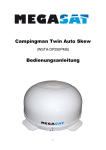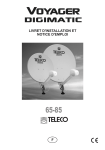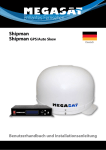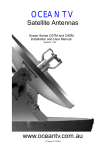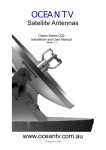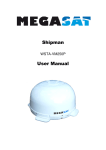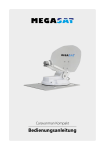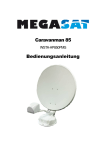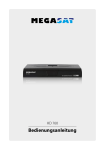Download Campingman Portable Twin Auto Skew User manual
Transcript
Campingman Portable Twin Auto Skew WSTA-PT250PMS User manual 10 I ntroduction Portable antenna system is the innovative and a technologically advanced satellite In-Motion system. Portable antenna has a unique combination of state-of-the art components with the most sophisticated satellite acquisition and tracking programs to provide the following features : ■ Fast satellite acquisition ■ Compatible with any Satellite Receiver ■ Compatible with all Direct Broadcast Satellites ■ Built-in Digital Broadcast Receiver ■ Capable of High Definition receiving Antenna System Overview A complete satellite TV system, illustrated in Figure 1-1, includes Portable antenna connected to a IDU, a satellite TV receiver, and a television set. Portable Antenna Unit Satellite Receiver TV Antenna Vehicle Power 12VDC~24VDC or power supply 230VAC/12VDC 5A TV Receiver IDU(In Door Unit) 11 System Components Antenna Unit The antenna unit houses the antenna positioning mechanism, LNB (low noise block), and control elements within a radome. Weathertight connectors join the power, signal, and control cabling from the below decks units. IDU(InDoor Unit) The IDU is the system’s user interface, providing access to the system and its functions through an LCD and three buttons. The IDU also serves as the vehicle’s junction box, allowing the system to use vehicle power, and supply and receive data to/from the antenna unit. 12 I nstallation This section offers a general explanation of how properly to install Portable antenna. Installation of Portable antenna must be accomplished by or under the supervision of an authorized dealer for the Limited Warranty to be valid and in force. The steps in the installation and setup process are as follows: Unpacking the unit 1. Open box and remove packing material. The following items are included in the packaging of Portable antenna. Description Item Quantity 1 Portable Antenna Unit 1 each 2 IDU(In Door Unit) 1 each 3 Power Cable 1 each 4 Coaxial Cable (1m) 1 eack 5 Coaxial Cable (10m) 1 each 6 Coaxial Cable (10m) 1 each 7 User Manual 1 set Preparing for the installation Install Tools and Materials Portable antenna system is designed for simple installation and setup. However, the following list of equipment or items should be available during installation of Portable antenna. 1. Verification of the Vehicle’s Power Supply. ■ Confirm that the vehicle’s power supply is 12VDC~24VDC. 2. Verification of the Satellite Receiver and IDU’s attachment and the electricity supply ■ Attach Satellite Receiver and IDU in the interior of the vehicle or the trunk. ■ Connect the power of Satellite Receiver and IDU. ■ Once the power of Satellite Receiver and IDU is verified, it confirms that both Satellite Receiver and IDU are working normally. 13 3. Procedure of the satellite’s attachment and installation. ■ Attach the satellite on the flat surface area of the vehicle’s roof. ■ Connect each end of the Coaxial antenna cable to the satellite’s terminal and the IDU. ■ Connect the IDU and the Satellite Receiver box together through the coaxial cable. ■ Make sure that the satellite is working normally, once the power is supplied. Warning : Things to consider when installing the antenna. ■ Turn off the power when attaching or detaching the antenna. ■ Make sure that the attached satellite is fixed on the flat surface. ■ When attaching, ensure that all the products are adhered properly. ■ Ensure that all the cables are connected properly. Selecting the location Determine the optimum mounting location for the antenna radom assembly. It should be installed where : 1. The antenna has a clear line-of-sight view to as much of the sky as is practical. Choose a location where masts or other structures do not block the satellite signal from the dish as the vehicle turns. 2. The antenna is at least 5 feet away from other transmitting antennas (HF, VHF and radar) that may generate signals that may interfere with Portable antenna. The further away Portable antenna is from these other antennas, the less impact their operation will have on it. 3. Direct radiation into the antenna from vehicles radar, especially high power surveillance radar arrays, is minimized. The radom should be as far away from the vehicles Radar as possible and should NOT be mounted on the same plane as the vehicles Radar. 4. The antenna radome assembly should be rigidly mounted to the vehicle. If necessary, reinforce the mounting area to assure that it does not flex due to the vehicle motion or vibration. If these conditions cannot be entirely satisfied, the site selection will inevitably be a “best” compromise between the various considerations. 14 The antenna must have a clear view of the sky and the horizon at all the directions to avoid blockage of the satellite signal. bad or no signal good signal Selecting the location bad case Equipment and cable installation This offers a general explanation of how to install the IDU and satellite receiver properly to the inside of vehicle connecting with coaxial cable. 1. The Coaxial cable is routed from the antenna to the IDU inside the vehicle. 2. After Once deciding where to place the IDU and satellite receiver, make sure that both units are placed in a dry and protected area. 3. The IDU and satellite receiver should be placed away from any heat source and in an area with proper ventilation. 4. Ensure that there are at least 3cm of space around both units for ventilation and connection of cables. Do not stack the units on top of each other. 5. The following describes the basic wiring configurations for Portable antenna system. ■ Connect the Coaxial cable to Potable antenna port on the back of the IDU ■ Connect one end of the supplied coaxial cable to the receiver port on the back of the IDU ■ Connect the other end of the coaxial cable to the satellite receiver 15 O peration Portable antenna system is easy to use. Under normal conditions, operation of Portable antenna requires no intervention from the user. Antenna unit initialization and satellite acquisition is completely automatic. Receiving Satellite TV Signals Television satellites are located in fixed positions above the Earth’s equator and beam TV signals down to certain regions of the planet. To receive TV signals from a satellite, you must be located within that satellite’s unique coverage area. To check it, see “Appendix A – Satellite Coverage Map” In addition, since TV satellites are located above the equator, Portable antenna must have a clear view of the sky to receive satellite TV signals. Anything that stands between the antenna and the satellite can block the signal, resulting in lost reception. Common causes of blockage include lighthouses, boat masts, trees, buildings, and bridges. Heavy rain, ice, or snow might also temporarily interrupt satellite signals. Turning the System On/Off Since power to Portable antenna system is controlled by the IDU, you can turn the antenna on or off by applying/removing operating power to the IDU. Turning on the System Follow the steps below to turn on your Portable antenna System. 1. Make sure the antenna has a clear view of the sky. 2. Turn on your satellite TV receiver and TV. 3. Apply operating power to the IDU. 4. Wait one minute for system startup. The IDU will display the Tracking Satellite screen after system testing is complete. Turning off the System Follow the steps below to turn off your Portable antenna System. 1. Remove operating power from the IDU. 2. Turn off your satellite TV receiver and TV. Changing Channels If you have followed the installation instructions, your system should be set to the satellite of your choice and the system should have downloaded the appropriate channel guides. When Portable antenna system and satellite receiver is properly configured, it is easy to change the channel using the remote control that normally comes with the receiver unit. 16 Watching TV Portable antenna is designed to operate as efficiently and as reliably as possible when the vehicle is moved and anchored. It is also the quickest satellite acquisition system available among Portable antennas. If you have anchored the vehicle and the antenna has completed to searching selected satellite, turn off IDU Power to avoid unnecessary use of power. Because the LNB receives its power from the Satellite Receiver through the IDU, the antenna will continue to receive the satellite TV signals. Switching between Satellites You can switch between satellites using the IDU by pressing Satellite select buttons. Follow the steps below to switch to another satellite. 1. Ensure that the LEDs turn on. If antenna is disconnected, all led will blink. LNB POWER LOCK 2. Press the Satellite select buttons to switch to another satellite. 3. The antenna shifts to track selected satellite. Wait for the Tracking Satellite screen. Operating the IDU Appearance Power S/W LNB ASTRA2 ASTRA ASTRA4 HISPSAT/TURKSAT ON OFF ASTRA3 POWER LOCK HOTBIRD THOR SATELLITE SELECT POWER Satellite select button 17 Functions of LCD Display Power S/W You can change the satellite by pushing this It is tracking a satellite. LNB ASTRA 2 ON OFF POWER ASTRA ASTRA 3 LOCK ASTRA4 HOTBIRD HISPASAT/TURKSAT THOR SATELLITE SELECT POWER It is Power. It is in lock mode. Satellite select button General Operation Order Turn the power switch on. ON OFF POWER . Push the Satellite select buttons to choose satellite. SATELLITE SELECT LNB Power Red LED turns on for searching the satellite. LOCK 18 LNB It is tracking the target satellite. POWER LOCK LNB Antenna lock choose satellite. POWER LOCK In case of search failure Turn the power switch on. ON OFF POWER Push the Satellite select buttons to choose satellite. SATELLITE SELECT LNB Red LED turns on for searching the satellite. POWER LOCK LNB POWER LOCK If the antenna cannot find selected satellite, it goes to sleep mode during about 2 minutes with turning on 2-LED. And then the antenna will search the satellite again. 19 T r oubleshooting There are a number of common issues that can affect the signal quality or the operation of Portable antenna system. The following sections address these issues and potential solutions. Simple check Can the antenna see the satellite? The antenna requires an unobstructed view of the sky to receive satellite TV signals. Common causes of blockage include trees, buildings, bridges, and mountains. Is there excessive dirt or moisture on the antenna dome? Dirt buildup or moisture on the dome can reduce satellite reception. Clean the exterior of the dome periodically. Is it raining heavily? Heavy rain or snow can weaken satellite TV signals. Reception should improve once the inclement weather subsides. Is everything turned on and connected properly? Make sure your TV and receiver are both turned on and set up for the satellite input. Finally, check any connecting cables to ensure none have come loose. Is the antenna’s LNB set to the correct skew angle? To optimize reception, the antenna’s LNB needs to be set to the correct skew angle for the satellite you want to track. 20 Causes and Remedies Receiver Fault Your satellite TV receiver might be set up incorrectly or defective. First check the receiver’s configuration to ensure it is set up for the desired programming. In the case of a faulty receiver, refer to your selected receiver’s user manual for service and warranty information. Satellite Coverage Issue Television satellites are located in fixed positions above the Earth’s equator and beam TV signals down to certain regions of the planet (not worldwide). To receive TV signals from a satellite, you must be located within that satellite’s unique coverage area. See “Appendix-A Satellite Coverage Map” Satellite Signal Blocked The Free Way 1S Antenna needs a clear line of sight (LOS), view to the satellite for uninterrupted reception. Objects such as tall lighthouse, bridges and big ship that block this view will cause a loss of signal. The signal will be quickly restored once the antenna has a clear line of sight again. Heavy rain, cloud, snow or ice may also interfere with the signal reception quality. If the satellite signal is lost due to blockage or severe weather condition, services from the receiver will be lost (picture will freeze frame and may disappear). When the satellite signal strength is again high enough, then the receiver will resume providing desired programming services. Satellite Frequency Data Changed If some channels work, while one or more other channels do not, or if the antenna cannot find the selected satellite, the satellite’s frequency data might have changed. You can visit any Continental-authorized dealer or distributor for assistance or visit http://wwwMegasat.tv Improper Wiring If the system has been improperly wired, the antenna will not operate correctly. Refer to the User Manual for complete system wiring information or visit website (http://www.Megasat.tv) Loose Cable Connectors We recommends periodically checking the antenna unit’s cable connections. A loose cable connector can reduce signal quality or prevent automatic satellite switching using the receiver’s remote control. Fasten the cable connector. 21 Anlage A AppendixA Europa Position - Raster Satellite Coverage Map Bitte entnehmen Sie der Tabelle Ihre Postion (1-25) Please refer to below table(1-25) Die Skew Anpassung (LNB Winkel), finden Sie in der Liste (Skew Anpassung) . Skew Adjustment(LNB Angle), find the table (Skew Adjustment) 22 Skew Anpassung Skew Adjustment Um die korrekte Skew Einstellung zu Überprüfen, entfernen Sie die Kuppel der Antenne und vergleichen Sie die LNB Einstellung mit den Tabellenwerten. If you want to check right skew set up, open the upper radome, compare the LNB angle with below position. Raster Position Grid Position TURKSAT 43°°E ASTRA2 28.2°°E ASTRA3 23.5°°E ASTRA1 19.2°°E HOTBIRD 13.0°°E Astra4 4.8°°E THOR 0.8°°W AB3 5.0°°W HISPASAT 30°°W 1 17° 13° 11° 10° 7° 3° 1° -1° -11° 2 14° 10° 8° 6° 4° 0° -3° -4° -14° 3 11° 6° 4° 2° -1° -4° -7° -9° -18° 4 6° 1° -1° -3° -5° -9° -11° -12° -20° 5 2° -2° -4° -6° -9° -12° -14° -15° -22° 6 22° 17° 14° 12° 9° 4° 1° -1° -15° 7 19° 13° 10° 8° 5° 0° -3° -6° -18° 8 15° 8° 5° 2° -1° -6° -9° -11° -22° 9 8° 2° -1° -3° -7° -11° -14° -16° -25° 10 1° -3° -6° -8° -11° -15° -18° -20° -27° 11 29° 21° 18° 16° 12° 6° 2° -2° -19° 12 25° 17° 13° 10° 6° 0° -4° -8° -23° 13 20° 10° 6° 3° -2° -7° -11° -14° -28° 14 10° 2° -1° -4° -9° -15° -18° -21° -32° 15 1° -4° -7° -10° -14° -20° -23° -25° -34° 16 35° 27° 23° 20° 15° 8° 2° -2° -23° 17 30° 21° 17° 14° 8° 0° -6° -10° -29° 18 24° 12° 8° 4° -2° -10° -15° -18° -34° 19 13° 3° -2° -6° -11° -18° -23° -26° -38° 20 1° -5° -9° -13° -18° -25° -28° -31° -41° 21 41° 33° 29° 25° 19° 9° 3° -2° -29° 22 36° 26° 21° 17° 10° 0° -7° -12° -35° 23 29° 16° 10° 5° -2° -12° -18° -23° -41° 24 16° 4° -2° -7° -14° -23° -28° -32° -45° 25 2° -6° -11° -16° -23° -30° -34° -37° -48° 23 Ausleuchtzonen Footprint Astra 2N Astra 2S 49dBW 49dBW Astra 1 Hotbird 49dBW 49dBW Fi 24 ASTRA4 Thor 2/3 49dBW 49dBW ASTRA 3 TURKSAT 25 Atlantic Bird 3 Hispasat 49dBW 49dBW Figure B-7 Atlantic bird 3 26 Technische Daten Specification Antennen Type Parabola Frequenz Band Ku Band Kuppel Abmessung Diameter Antennen Gewicht Antenna weight Antenna Gewinn Antenna Gain 430x440mm 5kg 31dBi Minimum EIRP 50dBW Polarisation V/H oder RHCP/LHCP Type of Stabilisation 2-Axis Stepp Motor Elevation Range 0° to 90° Azimuth Range Unlimited Tracking Rate 50°/sec Temperatur Bereich Temperature Range -20° to 70° Power 12~24VDC Megasat Industriestrasse 4a D- 97618 Niederlauer Tel. +49 (0) 9771 63567-100 Fax. +49 (0) 9771 63567-144 Homepage www.megasat.tv E-Mail: [email protected] 27


















